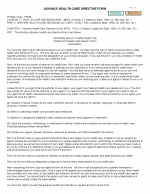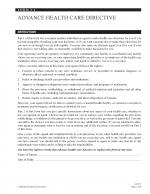A California advance directive allows a person to make their own pre-written health care decisions and select an agent to make decisions on their behalf. After completing, this form should be held by close family members in the event of an emergency. The agent is allowed to act and make decisions based on the instructions outlined in the advance directive.
Laws
Statutory Form – PROB § 4701
Signing Requirements (PROB § 4673(3)) – Two (2) witnesses or a notary public. For witnessing, a digital signature is sufficient.
State Definition (PROB § 4605) – “Advance health care directive” or “advance directive” means either an individual health care instruction or a power of attorney for health care.
Spanish (Español) Version – Adobe PDF
Versions (4)
Download: Adobe PDF
Download: Adobe PDF
Download: Adobe PDF
Download: Adobe PDF
How To Write
Download: Adobe PDF
Section 1.1. Designation Of Agent
(1) California Agent. The Private Party you have elected to handle health care and post death decisions on your behalf in the State of California must be identified with his or her full name.
(2) Address. The complete street address, city, state, and zip code where the your California Agent can be reached must be documented here. This paperwork will likely be used to identify your California Agent so make sure this information is reliable and up-to-date.
(3) Phone. California Medical Personnel (i.e. Physicians, Responders, etc.) utilizing this document to contact your Agent by phone may need to speak to him or her as soon as possible. Thus, provide the California Health Care Agent’s current home phone number as well as his or her work phone number.

(4) California Alternate Agent. The Party you elected for the California Health Care Agent role may not be available or able to use the principal authority to inform Medical Staff of your directives (i.e. incapacitation, extended travel, revocation). To make sure that someone is in place to automatically communicate your medical preferences to California Health Care Providers and Staff, you can appoint an Alternate Agent. The Alternate Agent, through this form, can wield the principal powers needed to consent, refuse, and otherwise manage your medical treatment with attending Physicians and Health Care Staff only when the role of California Health Care Agent becomes vacant. Report the name of the Alternate Agent to set this safeguard in motion.
(5) Alternate Agent Address.
(6) Alternate Agent Phone Number(s).

(7) Second Alternate Agent. In an effort to prepare for every scenario, it is worth considering the results of your First Alternate Agent being sought to convey your medical directives but being unable or unwilling to act in this role. The only reason your First Alternate Agent could be contacted for such instruction would be the absence or inability of your Health Care Agent to represent you. Therefore, this form allows for a Second Alternate Agent to be named and appointed to the Health Care Agent role in the State of California should both the previous parties be ineligible, unable, or unwilling. Identify the Second Alternate Agent by name if you intend to employ this precaution.
(8) Second Alternate Agent Address.
(9) Second Alternate Agent Phone.

Section 1.2 Agent’s Authority
(10) Limiting Agent Authority. The document being set forth will give your Health Care Agent the ability to make a host of decisions regarding your medical treatment unless you place specific limits or conditions on the level of representation powers he or she is assigned by state law. For instance, this form would give your Health Care Agent the ability to consent or refuse dialysis when you are incapacitated and likely to be permanently unconscious. You may make that decision and any others that are important to you directly in this form. Your direct instructions will take precedence over your Health Care Agent’s directions unless the instructions you provide are illegal or (extremely) unethical. You may also handle decisions such as the start date of your Agent’s powers and where you prefer to receive medical care by setting them to paper here. If you require more room to fully document your medical preferences then either insert more lines or, if preferred, develop a document with your principal instructions and physically attach it to this one. Make sure to refer to it in this section.

Section 1.3 Agent’s Authority Becomes Effective
(11) Set The Effective Date. The directive being completed can either become effective only when you are incapacitated and unable to communicate in any meaningful way (i.e. hand motions, eye-blinking, nodding) or it can be put into motion immediately allowing to your Health Care Agent to perform medical actions (i.e. picking up medicine, arranging transport and treatment, etc.) as soon as you sign it. To set it in effect immediately, the checkbox option provided in the declaration must be selected.

Section 1.5 Agent’s Post-death Authority
(12) Limiting Agent’s Post-death Authority. By default, the California Health Care Agent will be able to decide upon issues such as organ donation and funeral arrangements. Thus an area has been set aside so you can limit the Health Care Agent’s authority in these matters, place conditional statements on the decisions he or she makes (i.e. to control the costs of burial, cremation, etc.) or to issue your own directives. This area is entirely optional and can be tended to at your discretion.

Section 1.6 Nomination Of Conservator
(13) Conservator Nomination. A significant default status to consider is the nomination of your Conservator or Guardian. There may be a time when the court system of California decides that a formally bonded Guardian or Conservator must be assigned. This document automatically nominates your Health Care Agent then (in succession) Alternate Agents to this role. If this is inappropriate then cross out or remove the statement in section 6.

Section 2.1 End-Of-Life Decisions
(14) Prolonging Life Decision. While the first part of this form enables you to appoint a Health Care Representative in the State of California and discuss the level of authority you are giving him or her, the second part will seek your directives. This process begins by selecting a statement that either declares that you do not wish your life prolonged with treatment if you persistently unconscious, have an incurable or untreatable condition or where the medical treatment would be extremely burdensome or a statement declaring that you wish your life prolonged under any circumstances using available and acceptable medical treatment. These statements conflict one another, thus you may only choose one of them by marking the checkbox provided.

Section 2.2 Relief From Pain
(15) Exceptions To Pain Management. Generally California Medical Staff and Responders will attempt to manage your pain to an acceptable level of comfort either through medication or medical procedures. If you wish to limit their efforts by withholding your consent to some of the medications and procedures used for pain management (i.e. allergies, personal values, etc.), then you must do so through the area provided in this directive.

Section 2.3 California Principal Preferences
(16) Other Wishes. If you have any specific treatment goals or restrictions that you want California Medical Personnel to be aware of so that your treatment can be developed along your medical preferences then, you must put these preferences down on paper. If you are unconscious for a long period of time, the directives you set will be referred to by Physicians. For instance, you may be strongly against intubation or receiving aid in the form of blood transfusions or being an Organ Donor Recipient. Similarly, you may wish to only place certain conditions on treatments. Be sure to have a frank discussion with your Physician regarding medical treatments that may be employed and any medical scenarios you may find yourself in. Then record your medical treatment preferences, restrictions, and conditions directly in this paperwork (or as an attachment) before it is signed.

Section 3.1 Anatomical Gifts
(17) Organ Donation. You have the option of declaring the desire to be an organ donor by marking the checkbox to the appropriate acknowledgment statement. Additionally, you may restrict the purpose of your organ donation by reviewing the list of anatomical gift reasons then crossing out any that you wish excluded, and discuss any arrangements, preferences, or restrictions regarding your anatomical gifts or organ donations.

Section 4.1 Primary Physician
(18) Identify Primary Physician. If you have specific Doctor or Primary Care Physician that you wish contacted when you require medical attention in the State of California then report his or her name.
(19) Primary Physician Contact. After identifying your Primary Care Physician to Reviewers, furnish the complete address and phone number where he or she should be contacted regarding medical emergencies, requests for information, consultations, or admittance.

(20) Alternate Physician. You can name an Alternate Physician in case your Primary Care Physician is unavailable for an extended period of time during a medical emergency. To do so, record his or her full name.
(21) Alternate Physician Contact. The medical office, clinic, or hospital address where your Alternate Physician may be reached should be dispensed along with the phone number needed to contact him or her directly.

Section 5.2 Signature
(22) California Principal Signature. It is imperative that you sign this document as the California Principal to put in effect. This must be done before either the appropriate Witnesses or a Notary Public. Gather the Parties you choose to verify your act of signing then deliver the current date and your signature to the area provided.
(23) Principal Information. Document your address and printed name below your dated signature then release this document either the Witnesses present or the attending California Notary Public.

Section 5.3 Witness Statement
(24) First Witness Information. The First Witness must read the statement given. Before agreeing to it, the First Witness must present his or her identity by delivering his or her printed name and address.
(25) First Witness Signature. Once identified, the First Witness must sign and date this area as an acknowledgment.
(26) Second Witness Information. The Second Witness must fulfill the same requirement. He or she must review the statement, print his or her name, and document his or her address.
(27) Second Witness Signature. This document’s signing must be verified by at least two Witnesses, thus the Second Witness must sign and date the testimonial made.

Section 5.4 Additional Statement Of Witness
(28) Witness Testimonial. Both Witnesses must further attest that neither are related to the Principal (you) nor are they aware of any entitlements from your estate as the California Principal. To provide this additional testimony, each Witness must review then statement made then sign his or her name.

Section 6.1 State Of Patient Advocate Or Ombudsman
(29) Witnessing Advocate Or Ombudsman. If the California Principal behind this form is currently in a skilled nursing facility, then the Principal’s signing must be verified by the State Department of Aging’s assigned Patients Advocate or Ombudsman. He or she must review the Special Witness’s statement, then record the date and provide his or her signature. Once done, the Signature Witness (Patient Advocate or Ombudsman) must document his or her complete address and printed name.

California Notarization
(30) Notary Public Acknowledgment



